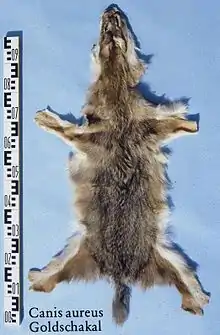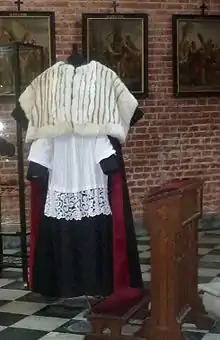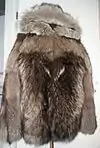List of types of fur
This list of types of fur describes the characteristics of types of fur used in fur clothing.
Beaver
Beaver fur has long been used in making muffs, stoles, collars, trimmings, and felt for hats.[1]
Faux
Faux fur or fake fur is a material made of synthetic fibers designed to resemble fur, normally as part of a piece of clothing.
Fisher
Fisher fur varies from grayish brown to nearly black. The fur measures about two and one-half inches in length. It is used mainly for muffs and neck, shoulder pieces.[1]
Fox
Red fox

Because of their abundance, red foxes are among the most important furbearing animals harvested by the fur trade. Their pelts are used for trimmings scarfs, muffs, jackets and coats. They are principally used as trimming for both cloth coats and fur garments, including evening wraps.[2] The pelts of silver-morph foxes are popular as capes,[3] while cross foxes are mostly used for scarfs and very rarely trimming.[4] The number of sold fox scarfs exceeds the total number of scarfs made from other furbearers. However, this amount is overshadowed by the total number of fox pelts used for trimming purposes.[2] The silver morphs are the most valued by furriers, followed by the cross and red morphs respectively.[5] In the early 20th century, over 1,000 American fox skins were imported to Britain annually, while 500,000 were exported annually from Germany and Russia.[6] The total worldwide trade of wild red foxes in 1985–86 was 1,543,995 pelts. Foxes amounted to 45% of US wild-caught pelts worth $50 million.[7]
North American red foxes, particularly those of northern Alaska, are the most valued for their fur, as they have guard hairs of a very silky texture that, after dressing, provide less restricted mobility to the wearer.[8] Red foxes in southern Alaska's coastal areas and the Aleutian Islands are an exception, as they have extremely coarse pelts that rarely exceed a third of the price of their northern Alaskan cousins.[9] Most European peltries have very coarse textured fur compared to North American varieties. The only exceptions are the Nordic and Far Eastern Russian peltries, but they are still inferior to North American peltries in terms of silkiness.[10]
Golden jackal

In Russia and other nations of the former Soviet Union, golden jackals are considered furbearers, albeit ones of low quality due to their sparse, coarse and monotonously coloured fur.[11] Asiatic and Near Eastern jackals produce the coarsest pelts, though this can be remedied during the dressing process. As jackal hairs have very little fur fibre, their skins have a flat appearance. The softest furs come from Elburz in northern Iran.[12] Jackals are known to have been hunted for their fur in the 19th century: in the 1880s, 200 jackals were captured annually in Mervsk. In the Zakatal area of the Trans-Caucasus, 300 jackals were captured in 1896. During that period, a total of 10,000 jackals had been taken within Russia, and were sent exclusively to the Nizhegorod fair. In the early 1930s, 20–25 thousand jackal skins were tanned annually in the Soviet Union, though the stocks were significantly underused, as over triple that amount could have been produced. Before 1949 and the onset of the Cold War, the majority of jackal skins were exported to the US. Despite their geographical variations, jackal skins are not graded according to a fur standard, and are typically used in the manufacture of cheap collars, women's coats and fur coats.[11] Jackal fur is still valued by the Kazakh people along the Caspian shoreline, as it is lighter and warmer than sheepskin.[13]
Marten
Marten fur, which is soft, somewhat resembling that of foxes, is about one and one-half inches long. The color varies from pale gray to orange-brown and dark brown.[1]
Mink
.jpg.webp)
Mink fur is durable. The hairs are rather short, but very thick and soft. The guard hairs do not break readily, and the underfur does not tend to become matted. Sunlight gradually fades its original dark brown color a warmer tone, making it less attractive.[14]
Nutria
Nutria, or coypu fur is traditionally sheared, dyed and plucked. Its light weight makes it suitable for linings as well as coats, accessories and trims. Sometimes is now used without shearing or plucking, with the most valuable furs being in the richer browns. It is sometimes promoted as a 'guilt-free' fur, as it is considered a pest in the southern United States.[15][16]
Otter
Otter fur is about an inch long, erect, and thick. It is durable, ranking with mink fur, and is used chiefly for trimming garments.[1]
Rabbit

Rabbit fur is commonly considered a byproduct of the process of breeding rabbits for meat, and as such is produced in large quantities in England and France; more than seventy million pelts a year in France alone.[17] However, the quality of fur from these rabbits tends to be low, as the rabbits are slaughtered before reaching twelve weeks old and still have the infant coat.
In temperate climates, the highest-quality furs are obtained in winter from rabbits over five months old, when the thickness of the fur is even; at other times of year, varying degrees of hair shedding causes uneven patches in the fur. The coat is also at its thickest at this time of year. The highest quality pelts are suitable for clothing, and typically constitute less than half of all pelts collected. The hair of the Angora rabbit is preferred due to its length, caused by an unusually long growth phase in the hair cycle, the consequence of a recessive gene.
Raccoon
Raccoon fur is mottled gray in color and about two and one-half inches long on animals from northern United States. In the southern United States the fur is shorter.[1] Raccoon fur reached a heyday in the United States during the 1920s, when raccoon coats became fashionable among college students to stay warm while traveling in automobiles and attending football games.[18]
Sable
The sable, a species of marten, is primarily found in Russia through the Ural Mountains of Siberia. Their fur is soft and silkier than American martens and is mostly used for jackets, scarfs, and hats and gloves. [19] Crown sable (also known as Russian or Imperial sable) was the finest and most expensive quality of sable.[20]
Skunk
Skunk fur is of medium length, erect, and possesses a sheen. However, protracted use causes it to fade from a glistening black to a dull reddish brown.[14] Before the mid-20th century, skunk fur was also described and marketed as "Alaska sable".[21]
Grey wolf

Wolf pelts are primarily used for scarfs and the trimmings of women's garments, though they are occasionally used for jackets, short capes, coats,[22] mukluks and rugs.[23] The quality of wolf peltries rests on the density and strength of the fur fibre, which keeps the fur upright and gives the pelt an appealing bushy aspect. These characteristics are mostly found in northern wolf populations, but gradually lessen further south in warmer climates. North American wolf pelts are among the most valuable, as they are silkier and fluffier than Eurasian peltries.[22] The pelts of wolves killed by poison are mostly worthless.[24]
In Medieval Europe, pelts were considered the only practical aspect of wolves, though they were seldom used, due to the skin's foul odour.[25] In Scandinavian folklore, wolf-skin girdles assisted in transforming the wearers into werewolves.[26] Several Native American tribes used wolf pelts for medicinal purposes,[27] though some Inuit tribes favour dog skin over wolf skin, as the latter is thinner, and more prone to tearing when sewn.[28] The Pawnee wore wolf skins as capes when exploring enemy territories.[29] The United States Army used wolf skin for parkas during the later stages of WWII and the Korean War to protect the faces of soldiers from frostbite.[22] In the Soviet Union, between 1976 and 1988, 30,000 wolf pelts were produced annually. Recent statistics from CITES indicate that 6,000–7,000 wolf skins are internationally traded each year, with Canada, the former Soviet Union, Mongolia and China being the largest exporters, and the United States and Great Britain being the largest importers. Overall, the harvesting of wolves for their fur has little impact on their population, as only the northern varieties (whose numbers are stable) are of commercial value.[30] Wolf trapping for fur remains a lucrative source of income for many Native Americans.[23]
Australian brushtail possum
The Australian brushtail possum (paihamu in Maori) was introduced to New Zealand in 1837, where unlike Australia, there are no natural predators. This has resulted in an enormous wild population, approximately 70 million, that has a catastrophic effect on natural vegetation. Not to be confused with the North American opossum, a different animal, the paihamu eat their way through an estimated 20,000 tonnes of greenery each night. They are legally considered a pest. Since the mid-1990s, New Zealand manufacturers have been developing techniques to spin the hollow possum fur fibres with other yarns, such as merino wool and silk, creating a unique fabric of incomparable quality, warmth and durability. Amongst the top three warmest furs in the world, along with the Polar bear and Arctic fox, possum fur has become a viable eco-fur.
| Wikimedia Commons has media related to Furs by species. |
References
Notes
- American Fox and Fur Farmer (1921)
p. 13.
 This article incorporates text from this source, which is in the public domain.
This article incorporates text from this source, which is in the public domain. - Bachrach 1953, pp. 229–30
- Bachrach 1953, p. 246
- Bachrach 1953, p. 252
- Dale 1906, p. 207
- Dale 1906, p. 204
- Sillero-Zubiri, Hoffman & MacDonald 2004, p. 134
- "The Fur Trade: The Journey from Trap to Market". Outdoor Life. Retrieved 10 September 2016.
- Bachrach 1953, pp. 231–32
- Bachrach 1953, p. 235
- Heptner & Naumov 1998, pp. 160–61
- Bachrach 1953, p. 216
- Animals of the Caspian Sea
- American Fox and Fur Farmer (August 1921), p. 12.
 This article incorporates text from this source, which is in the public domain.
This article incorporates text from this source, which is in the public domain. - "Fur types in brief". furcommission.com. Fur Commission. Retrieved 26 October 2014.
- Grossman, Anna Jane (17 November 2010). "Is their pest your clean conscience?". New York Times. Retrieved 26 October 2014.
- Lebas, F.; Coudert, P.; Rouvier, R.; de Rochambeau, H. (1986). "The rabbit husbandry, health and production". Rome: Food and Agriculture Organization of the United Nations. Retrieved 7 May 2014.
- Wilcox, R. Turner (2010). The Mode in Furs: A Historical Survey with 680 Illustrations. Courier Corporation. ISBN 978-0-486-47872-2.
- "Different types of Fur Bobble Hats". www.bklyn.co.uk. Retrieved 11 September 2016.
- "Furs". Ballou's Monthly Magazine. Elliott, Thomes & Talbot. 23: 492–493. 1866. Retrieved 14 February 2013.
- Laut, Agnes C. The Fur Trade of America, p. 43. ISBN 9780766196162 (2004 reprint of 1921 edition)
- Bachrach 1953, pp. 205–13
- Mech 1974
- Harding 1909, p. 108
- Griffin, Emma (2007). Blood sport: hunting in Britain since 1066. Yale University Press. p. 65. ISBN 978-0-300-11628-1.
- Woodward, Ian The Werewolf Delusion (1979) p. 121, Paddington Press Ltd. ISBN 0-448-23170-0
- Lopez 1978, p. 105
- Coppinger & Coppinger 2001, p. 55
- Lopez 1978, pp. 111–112
- Mech & Boitani 2003, p. 329
Bibliography
- Bachrach, Max (1953). "Fur: a practical treatise". New York : Prentice-Hall, 3rd edition. Cite journal requires
|journal=(help) - Coppinger, Ray; Coppinger, Lorna (2001). Dogs: a Startling New Understanding of Canine Origin, Behavior and Evolution. Scribner. ISBN 0-684-85530-5.
- Dale, Thomas Francis (1906). "The fox". Longmans, Green, and Co. Cite journal requires
|journal=(help) - Harding, Arthur Robert (1909). "Wolf and coyote trapping; an up-to-date wolf hunter's guide, giving the most successful methods of experienced "wolfers" for hunting and trapping these animals, also gives their habits in detail". Columbus, Ohio, A. R. Harding pub. co. Cite journal requires
|journal=(help) - Lopez, Barry H. (1978). Of Wolves and Men. J. M. Dent and Sons Limited. ISBN 0-7432-4936-4.
- Mech, L. David (2 May 1974). "Canis lupus, Mamallian Species No. 37, pp. 1–6, 5 figs." (PDF). The American Society of Mammologists. Cite journal requires
|journal=(help) - Mech, L. David; Boitani, Luigi (2003). Wolves: Behaviour, Ecology and Conservation. University of Chicago Press. ISBN 0-226-51696-2.
- Sillero-Zubiri, Claudio; Hoffman, Michael; MacDonald, David W. (2004), Canids: Foxes, Wolves, Jackals and Dogs – 2004 Status Survey and Conservation Action Plan (PDF), IUCN/SSC Canid Specialist Group, ISBN 2-8317-0786-2, archived from the original (PDF) on 2011-05-19